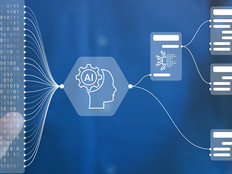Advanced IT Tools Support the AI Pipeline
Advanced technologies help bring algorithms closer to the data. These technologies include high-speed processors, large memory capacities and AI acceleration tools — all of which can support an effective AI pipeline.
For example, high-speed processors with built-in tools for quantization, distillation, pruning and other AI acceleration techniques work with 5G connectivity to deliver more data, more quickly.
Supported by these tools, it becomes possible to leverage Linux containers. A Linux container includes all the services an application needs to run in a single, highly portable package.
“Containerizing” an algorithm, along with all the microservices needed to run it, eliminates the need to send data back to the cloud for processing. Instead, developers can make use of readily available, small form-factor computing and storage, as well as the 5G communication path, to provide better intelligence at the edge.
End-to-end AI has big potential benefits for federal agencies. In addition to providing actionable intelligence at the point of origin, an end-to-end approach can it make less expensive to process data while making it easier to retrain and refine the AI as new data emerges.
DIVE DEEPER: Data analysis helps federal agencies move decisively in a crisis.
How End-to-End AI Can Save Lives
For the Department of Defense, an end-to-end strategy can literally save lives by getting information and resources out to troops faster and more effectively, based on AI-driven insights into battlefield data. The same holds true across a range of other urgent federal missions.
Agricultural experts, for example, need timely feedback to support precision agriculture, responding to emerging needs with crucial insights around water and pesticide use. Health agencies need rapid analytics to deliver needed services in the face of public health emergencies.
There’s a benefit for federal law enforcement as well, which can tap into data feeds from a range of sources, from social media comments to CCTV cameras to travel records.
With tools like natural language processing and computer vision, investigators increasingly are using AI to connect the dots in cases of human trafficking, child abductions, money laundering and other criminal activity. In all these situations, a streamlined and speeded-up AI pipeline can help drive improved outcomes.
REVIEW: The the intelligence community is developing new uses for AI.
Take the Right Path to an End-to-End Approach
Federal agencies can start today to lay the groundwork for an end-to-end AI implementation.
They can begin by putting in place an overall data strategy. To do that, they must first consider what data they have on hand and what problems they are trying to solve. The data strategy can help align the resources to the need, highlighting the places where an accelerated approach to AI could help bring that data to life.
In creating your data strategy, it is important to have an open programming model and build in applications that are open-source capable and low code. This opens the door to leveraging agencies’ strong domain expertise to map out the data journey from edge to data center and into the cloud.
Second, agencies should look at their edge resources. Who are the users at the edge, and what are their needs? What devices are operating at the edge both to generate data and to act on AI-supported insights? Leaders can start now to think about what additional technology resources are necessary to support an end-to-end approach.
By laying the groundwork today, agencies can position themselves to leverage end-to-end AI in support of their most critical data-driven operations. They can bring the algorithms closer to the sources of data, delivering faster results and driving enhanced mission outcomes.










